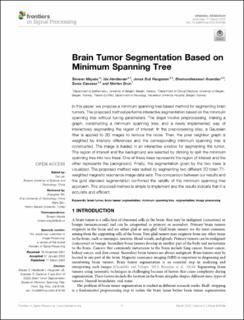| dc.contributor.author | Mayala, Simeon Sahani | |
| dc.contributor.author | Herdlevær, Ida Ajvazi | |
| dc.contributor.author | Haugsøen, Jonas Bull | |
| dc.contributor.author | Anandan, Shamundeeswari | |
| dc.contributor.author | Gavasso, Sonia | |
| dc.contributor.author | Brun, Morten | |
| dc.date.accessioned | 2023-08-16T11:25:11Z | |
| dc.date.available | 2023-08-16T11:25:11Z | |
| dc.date.created | 2022-03-13T13:10:05Z | |
| dc.date.issued | 2022-03-11 | |
| dc.identifier.issn | 2673-8198 | |
| dc.identifier.uri | https://hdl.handle.net/11250/3084381 | |
| dc.description.abstract | In this paper, we propose a minimum spanning tree-based method for segmenting brain tumors. The proposed method performs interactive segmentation based on the minimum spanning tree without tuning parameters. The steps involve preprocessing, making a graph, constructing a minimum spanning tree, and a newly implemented way of interactively segmenting the region of interest. In the preprocessing step, a Gaussian filter is applied to 2D images to remove the noise. Then, the pixel neighbor graph is weighted by intensity differences and the corresponding minimum spanning tree is constructed. The image is loaded in an interactive window for segmenting the tumor. The region of interest and the background are selected by clicking to split the minimum spanning tree into two trees. One of these trees represents the region of interest and the other represents the background. Finally, the segmentation given by the two trees is visualized. The proposed method was tested by segmenting two different 2D brain T1-weighted magnetic resonance image data sets. The comparison between our results and the gold standard segmentation confirmed the validity of the minimum spanning tree approach. The proposed method is simple to implement and the results indicate that it is accurate and efficient. | en_US |
| dc.language.iso | eng | en_US |
| dc.publisher | Frontiers | en_US |
| dc.rights | Navngivelse 4.0 Internasjonal | * |
| dc.rights.uri | http://creativecommons.org/licenses/by/4.0/deed.no | * |
| dc.title | Brain Tumor Segmentation Based on Minimum Spanning Tree | en_US |
| dc.type | Journal article | en_US |
| dc.type | Peer reviewed | en_US |
| dc.description.version | publishedVersion | en_US |
| dc.rights.holder | Copyright 2023 the authors | en_US |
| dc.source.articlenumber | 816186 | en_US |
| cristin.ispublished | true | |
| cristin.fulltext | original | |
| cristin.qualitycode | 1 | |
| dc.identifier.doi | 10.3389/frsip.2022.816186 | |
| dc.identifier.cristin | 2009302 | |
| dc.source.journal | Frontiers in Signal Processing | en_US |
| dc.subject.nsi | VDP::Bioinformatikk: 475 | en_US |
| dc.subject.nsi | VDP::Bioinformatics: 475 | en_US |
| dc.identifier.citation | Frontiers in Signal Processing. 2022, 2, 816186. | en_US |
| dc.source.volume | 2 | en_US |

